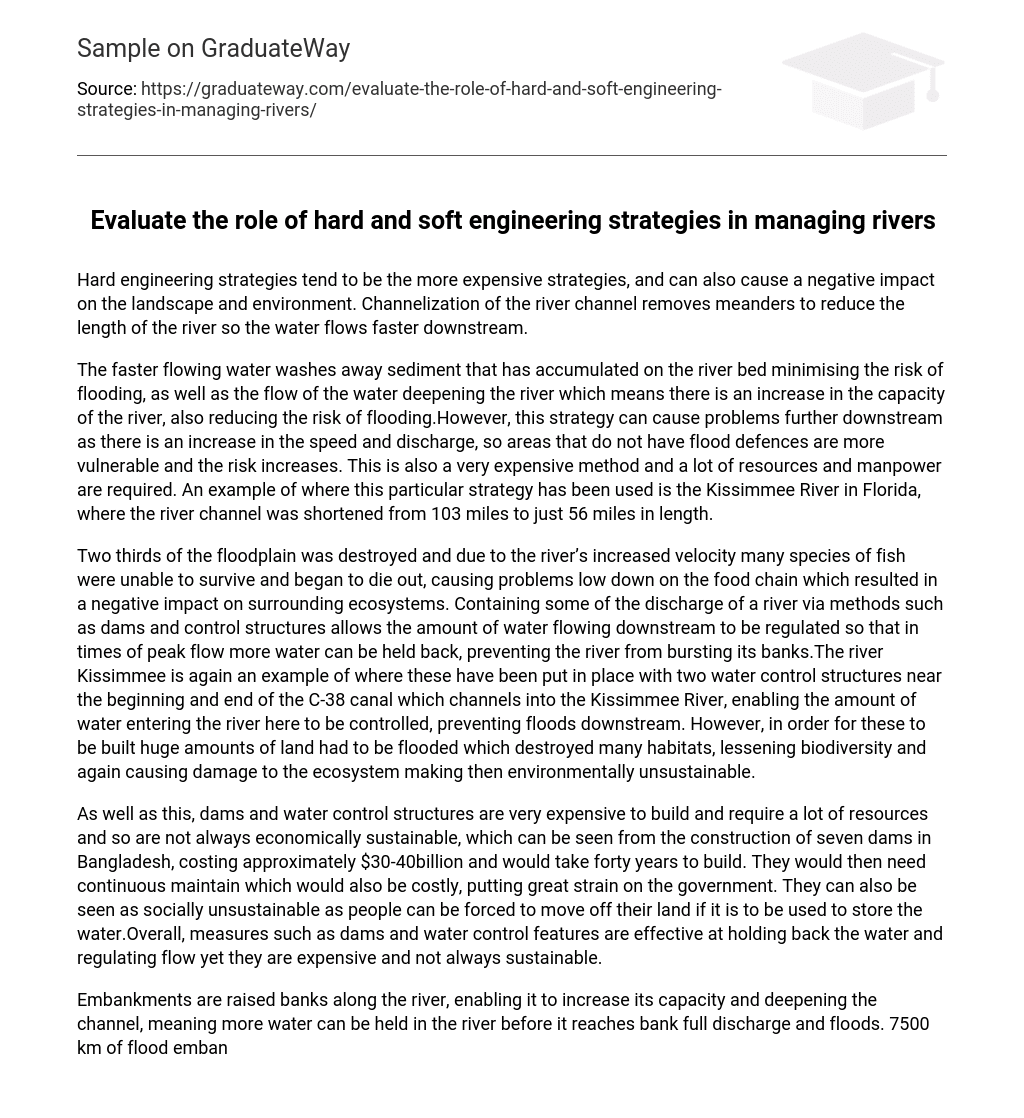The Channelization of the river channel is an example of a hard engineering strategy. This strategy is typically expensive and can have a detrimental impact on the landscape and environment. By removing meanders, the length of the river is reduced and the water is able to flow downstream at a faster pace.
The acceleration of water flow helps remove sediment from the river bed, reducing flood risks and deepening the river, which increases its capacity and further decreases flood risks. However, this approach can pose challenges downstream, as it intensifies the flow and discharge, leaving areas without flood defenses more susceptible. Moreover, this method is costly and demands significant resources and manpower. The Kissimmee River in Florida serves as an example where this strategy was implemented by shortening the river channel from 103 to 56 miles.
Two-thirds of the floodplain was destroyed, resulting in the death of many fish species due to the increased velocity of the river. This disruption in the food chain negatively impacted the surrounding ecosystems. Implementing measures like dams and control structures can regulate the discharge of a river, allowing for the management of water flow downstream and preventing flooding. The river Kissimmee serves as an example, with two water control structures in place along the C-38 canal that channels into the Kissimmee River. These structures control the amount of water entering the river, thus preventing floods downstream. However, constructing these structures required flooding vast amounts of land, leading to habitat destruction and a decrease in biodiversity. Consequently, they have proven to be environmentally unsustainable.
Furthermore, the costly nature and resource requirements of dams and water control structures undermine their financial viability. This is evident in Bangladesh’s scenario, where the building of seven dams necessitates a $30-40 billion investment spanning four decades. Moreover, these structures demand ongoing maintenance expenses that would strain the government financially. Societally, constructing dams may lead to mandatory displacement of individuals from their properties to accommodate water storage needs. In conclusion, while dams and water control features effectively regulate water flow, their substantial expense and limited sustainability pose significant challenges.
The purpose of embankments in Bangladesh is to increase the capacity and depth of river channels, preventing flooding by holding more water before it reaches bank full discharge. Since 1947, approximately 7500 km of flood embankments have been built in the country. While these embankments have successfully controlled smaller floods, they are not designed to withstand extreme floods like those that occurred in 1998. As a result, when the embankments collapsed during this event, large amounts of water flooded the surrounding areas. This issue was worsened by the fact that the river had been deepened, allowing for greater discharge. As a consequence, the embankments hindered backflow into the river, trapping water and exacerbating problems.
Embankments/levees are both easy to construct and costly, making them unsustainable in the long term. Alternatively, soft management strategies can be implemented to mitigate flooding. Washlands, for instance, are intentionally flooded areas within floodplains that lessen the probability of downstream flooding. This approach is economically sustainable due to its zero cost and environmentally sustainable as it preserves the washland ecosystem.
However, socially sustainable practices are not always ensured in the creation of washland areas, as individuals can be displaced and forced to leave their property. An alternative method that promotes soft strategies is land use zoning. This approach has been employed in both the Kissimmee river and the town of Shrewsbury, which is situated within a river meander. Building regulations differ based on the proximity to the river. Adjacent land remains unused, and as distance from the river grows, the value and quality of the land increase due to its decreased likelihood of flooding.
Despite their limitations, html tags can be used to mitigate the impacts of flooding. However, they fail to fully prevent flooding and may result in increased insurance costs for those residing in high-risk areas. In contrast, afforestation offers a sustainable approach to addressing this issue. Not only is it economically feasible, but it also promotes environmental sustainability by creating habitats that support biodiversity. Moreover, afforestation has social sustainability benefits as it does not negatively affect any individuals. Nevertheless, this solution is not without drawbacks as it requires considerable time for trees to mature and only provides partial interception of rainfall, thereby lacking the ability to prevent severe flooding.
Generally, hard engineering measures like embankments, water control features, dams, and channelization are more efficient compared to soft engineering strategies like washland areas and land use zoning. Nevertheless, hard engineering approaches are significantly more expensive and environmentally costly.





